Aircraft 4: Thesis/Dissertation on Energy and Aircraft Cruise Stage
VerifiedAdded on 2022/09/27
|16
|3849
|26
Thesis and Dissertation
AI Summary
This thesis provides a detailed analysis of the forces acting on an aircraft during the cruise stage of flight. The research examines the equilibrium conditions where lift, weight, thrust, and drag are balanced, and explains how tailplanes contribute to stability, control, and maintaining equilibrium. The study covers the forces, body diagrams, translational and rotational conditions, and exemplar calculations. The work further discusses the impact of forces during pitching moments, the influence of airspeed and angle of attack, and the role of tailplanes in high and low-speed scenarios. The thesis incorporates calculations to illustrate these principles, concluding with a discussion of the overall dynamics of aircraft in the cruise phase.
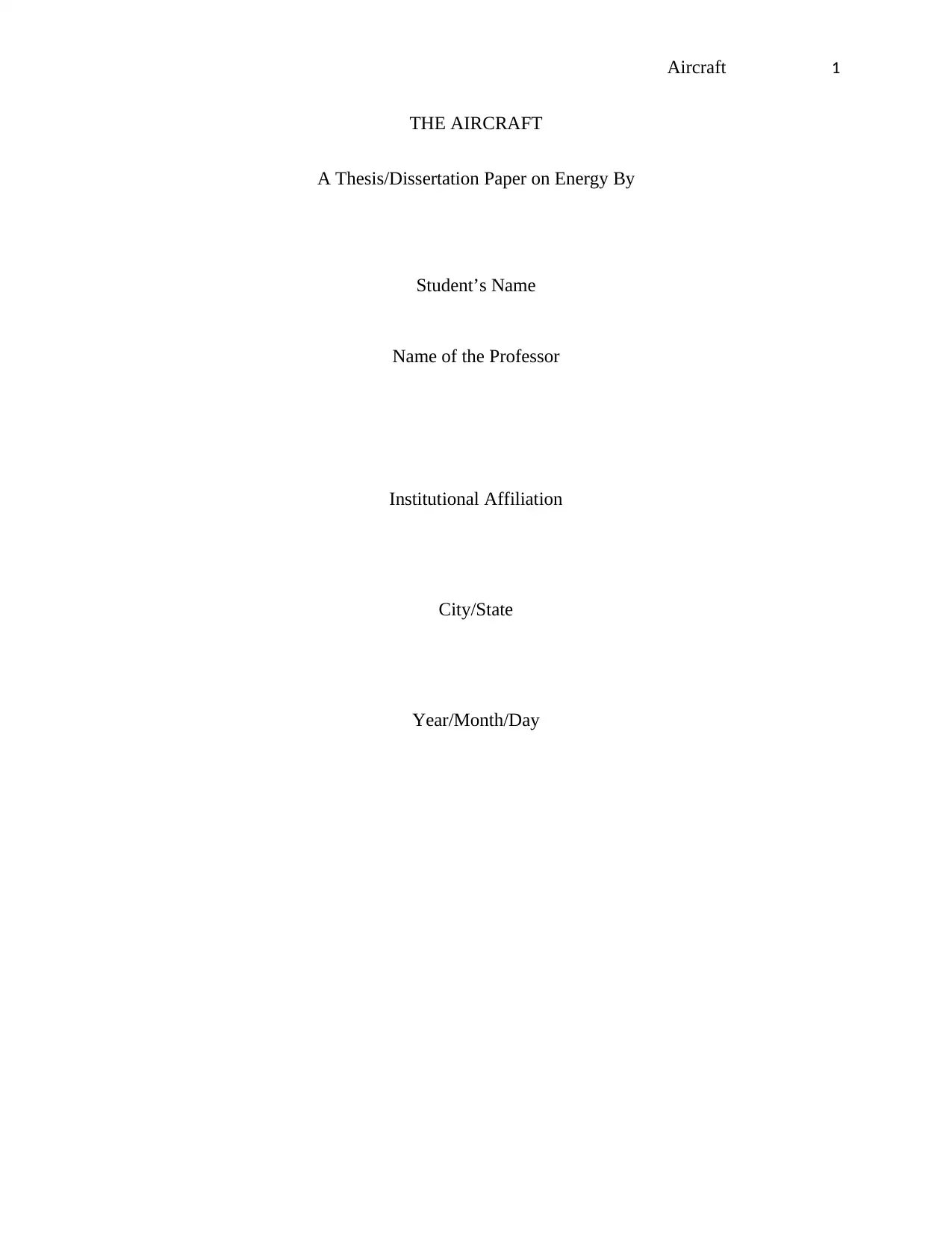
Aircraft 1
THE AIRCRAFT
A Thesis/Dissertation Paper on Energy By
Student’s Name
Name of the Professor
Institutional Affiliation
City/State
Year/Month/Day
THE AIRCRAFT
A Thesis/Dissertation Paper on Energy By
Student’s Name
Name of the Professor
Institutional Affiliation
City/State
Year/Month/Day
Paraphrase This Document
Need a fresh take? Get an instant paraphrase of this document with our AI Paraphraser
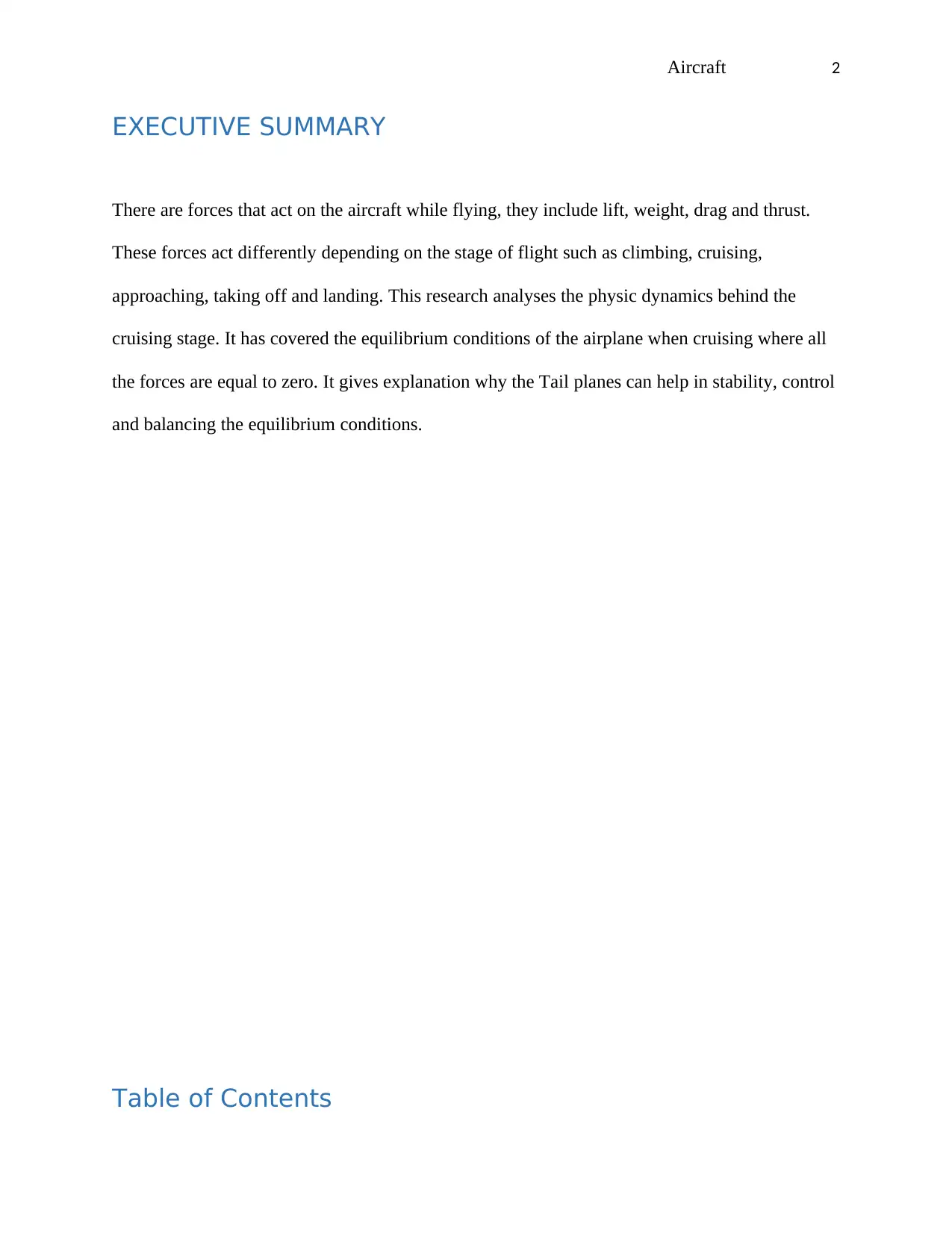
Aircraft 2
EXECUTIVE SUMMARY
There are forces that act on the aircraft while flying, they include lift, weight, drag and thrust.
These forces act differently depending on the stage of flight such as climbing, cruising,
approaching, taking off and landing. This research analyses the physic dynamics behind the
cruising stage. It has covered the equilibrium conditions of the airplane when cruising where all
the forces are equal to zero. It gives explanation why the Tail planes can help in stability, control
and balancing the equilibrium conditions.
Table of Contents
EXECUTIVE SUMMARY
There are forces that act on the aircraft while flying, they include lift, weight, drag and thrust.
These forces act differently depending on the stage of flight such as climbing, cruising,
approaching, taking off and landing. This research analyses the physic dynamics behind the
cruising stage. It has covered the equilibrium conditions of the airplane when cruising where all
the forces are equal to zero. It gives explanation why the Tail planes can help in stability, control
and balancing the equilibrium conditions.
Table of Contents
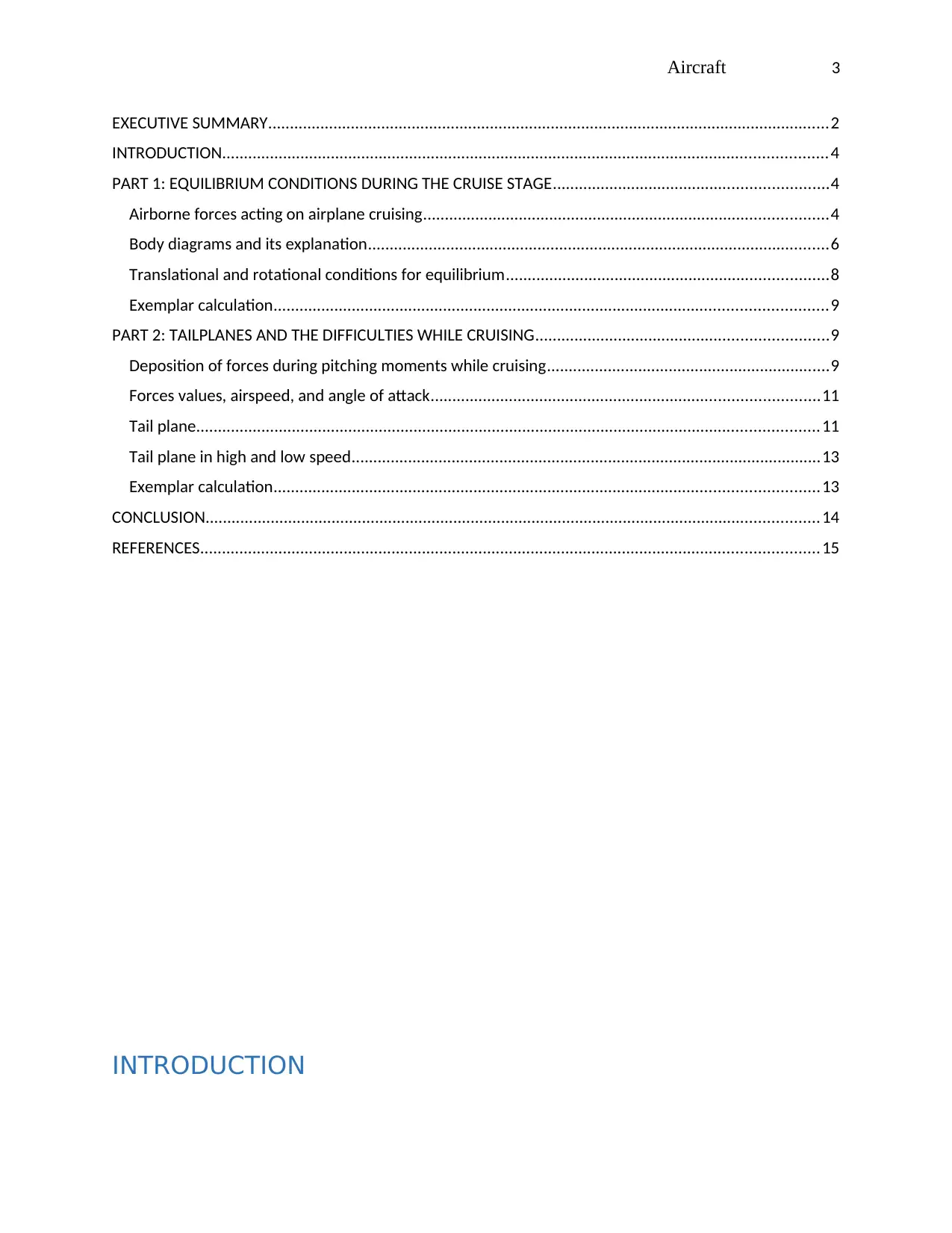
Aircraft 3
EXECUTIVE SUMMARY.................................................................................................................................2
INTRODUCTION...........................................................................................................................................4
PART 1: EQUILIBRIUM CONDITIONS DURING THE CRUISE STAGE...............................................................4
Airborne forces acting on airplane cruising.............................................................................................4
Body diagrams and its explanation..........................................................................................................6
Translational and rotational conditions for equilibrium..........................................................................8
Exemplar calculation...............................................................................................................................9
PART 2: TAILPLANES AND THE DIFFICULTIES WHILE CRUISING...................................................................9
Deposition of forces during pitching moments while cruising.................................................................9
Forces values, airspeed, and angle of attack.........................................................................................11
Tail plane...............................................................................................................................................11
Tail plane in high and low speed............................................................................................................13
Exemplar calculation.............................................................................................................................13
CONCLUSION.............................................................................................................................................14
REFERENCES..............................................................................................................................................15
INTRODUCTION
EXECUTIVE SUMMARY.................................................................................................................................2
INTRODUCTION...........................................................................................................................................4
PART 1: EQUILIBRIUM CONDITIONS DURING THE CRUISE STAGE...............................................................4
Airborne forces acting on airplane cruising.............................................................................................4
Body diagrams and its explanation..........................................................................................................6
Translational and rotational conditions for equilibrium..........................................................................8
Exemplar calculation...............................................................................................................................9
PART 2: TAILPLANES AND THE DIFFICULTIES WHILE CRUISING...................................................................9
Deposition of forces during pitching moments while cruising.................................................................9
Forces values, airspeed, and angle of attack.........................................................................................11
Tail plane...............................................................................................................................................11
Tail plane in high and low speed............................................................................................................13
Exemplar calculation.............................................................................................................................13
CONCLUSION.............................................................................................................................................14
REFERENCES..............................................................................................................................................15
INTRODUCTION
⊘ This is a preview!⊘
Do you want full access?
Subscribe today to unlock all pages.

Trusted by 1+ million students worldwide
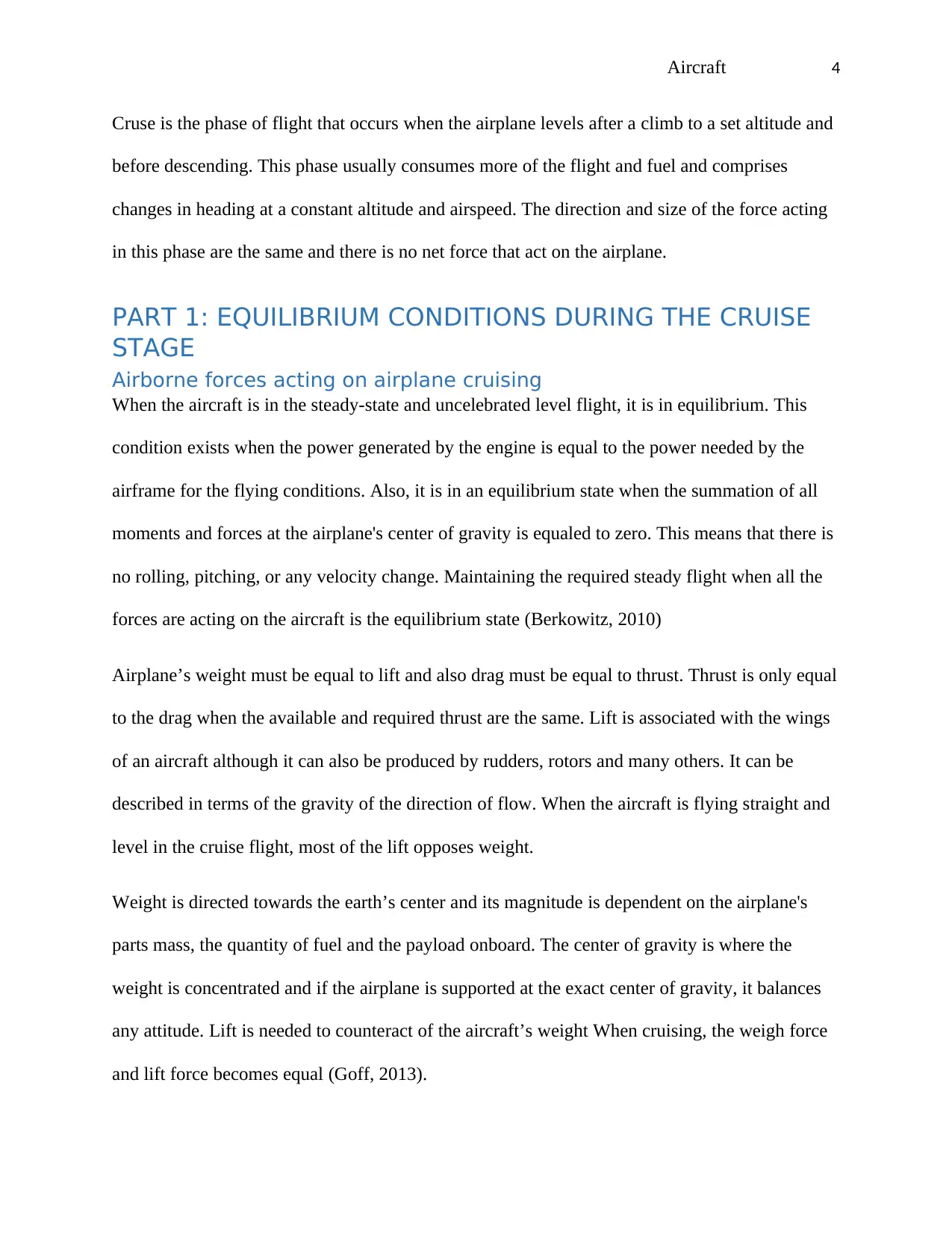
Aircraft 4
Cruse is the phase of flight that occurs when the airplane levels after a climb to a set altitude and
before descending. This phase usually consumes more of the flight and fuel and comprises
changes in heading at a constant altitude and airspeed. The direction and size of the force acting
in this phase are the same and there is no net force that act on the airplane.
PART 1: EQUILIBRIUM CONDITIONS DURING THE CRUISE
STAGE
Airborne forces acting on airplane cruising
When the aircraft is in the steady-state and uncelebrated level flight, it is in equilibrium. This
condition exists when the power generated by the engine is equal to the power needed by the
airframe for the flying conditions. Also, it is in an equilibrium state when the summation of all
moments and forces at the airplane's center of gravity is equaled to zero. This means that there is
no rolling, pitching, or any velocity change. Maintaining the required steady flight when all the
forces are acting on the aircraft is the equilibrium state (Berkowitz, 2010)
Airplane’s weight must be equal to lift and also drag must be equal to thrust. Thrust is only equal
to the drag when the available and required thrust are the same. Lift is associated with the wings
of an aircraft although it can also be produced by rudders, rotors and many others. It can be
described in terms of the gravity of the direction of flow. When the aircraft is flying straight and
level in the cruise flight, most of the lift opposes weight.
Weight is directed towards the earth’s center and its magnitude is dependent on the airplane's
parts mass, the quantity of fuel and the payload onboard. The center of gravity is where the
weight is concentrated and if the airplane is supported at the exact center of gravity, it balances
any attitude. Lift is needed to counteract of the aircraft’s weight When cruising, the weigh force
and lift force becomes equal (Goff, 2013).
Cruse is the phase of flight that occurs when the airplane levels after a climb to a set altitude and
before descending. This phase usually consumes more of the flight and fuel and comprises
changes in heading at a constant altitude and airspeed. The direction and size of the force acting
in this phase are the same and there is no net force that act on the airplane.
PART 1: EQUILIBRIUM CONDITIONS DURING THE CRUISE
STAGE
Airborne forces acting on airplane cruising
When the aircraft is in the steady-state and uncelebrated level flight, it is in equilibrium. This
condition exists when the power generated by the engine is equal to the power needed by the
airframe for the flying conditions. Also, it is in an equilibrium state when the summation of all
moments and forces at the airplane's center of gravity is equaled to zero. This means that there is
no rolling, pitching, or any velocity change. Maintaining the required steady flight when all the
forces are acting on the aircraft is the equilibrium state (Berkowitz, 2010)
Airplane’s weight must be equal to lift and also drag must be equal to thrust. Thrust is only equal
to the drag when the available and required thrust are the same. Lift is associated with the wings
of an aircraft although it can also be produced by rudders, rotors and many others. It can be
described in terms of the gravity of the direction of flow. When the aircraft is flying straight and
level in the cruise flight, most of the lift opposes weight.
Weight is directed towards the earth’s center and its magnitude is dependent on the airplane's
parts mass, the quantity of fuel and the payload onboard. The center of gravity is where the
weight is concentrated and if the airplane is supported at the exact center of gravity, it balances
any attitude. Lift is needed to counteract of the aircraft’s weight When cruising, the weigh force
and lift force becomes equal (Goff, 2013).
Paraphrase This Document
Need a fresh take? Get an instant paraphrase of this document with our AI Paraphraser
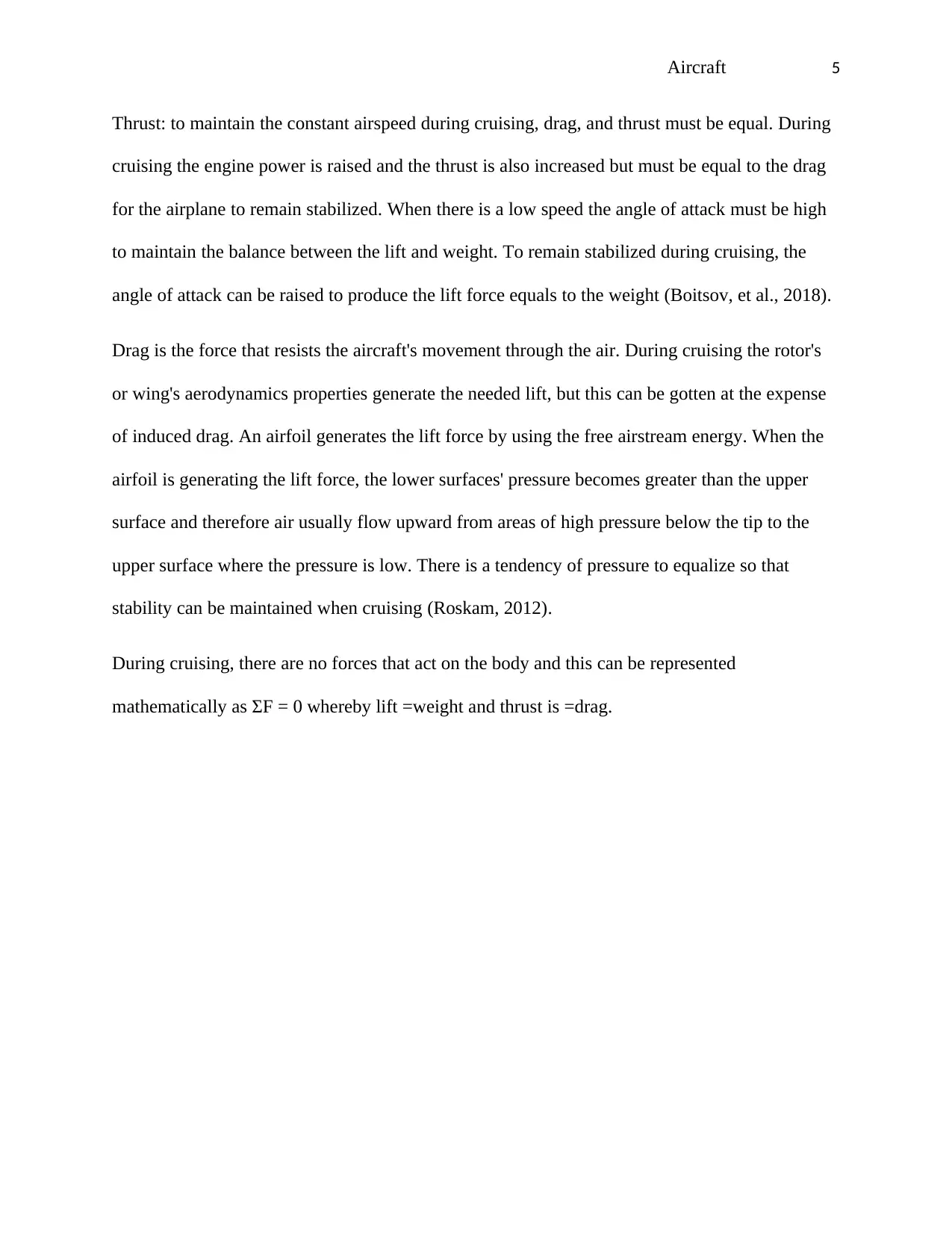
Aircraft 5
Thrust: to maintain the constant airspeed during cruising, drag, and thrust must be equal. During
cruising the engine power is raised and the thrust is also increased but must be equal to the drag
for the airplane to remain stabilized. When there is a low speed the angle of attack must be high
to maintain the balance between the lift and weight. To remain stabilized during cruising, the
angle of attack can be raised to produce the lift force equals to the weight (Boitsov, et al., 2018).
Drag is the force that resists the aircraft's movement through the air. During cruising the rotor's
or wing's aerodynamics properties generate the needed lift, but this can be gotten at the expense
of induced drag. An airfoil generates the lift force by using the free airstream energy. When the
airfoil is generating the lift force, the lower surfaces' pressure becomes greater than the upper
surface and therefore air usually flow upward from areas of high pressure below the tip to the
upper surface where the pressure is low. There is a tendency of pressure to equalize so that
stability can be maintained when cruising (Roskam, 2012).
During cruising, there are no forces that act on the body and this can be represented
mathematically as ΣF = 0 whereby lift =weight and thrust is =drag.
Thrust: to maintain the constant airspeed during cruising, drag, and thrust must be equal. During
cruising the engine power is raised and the thrust is also increased but must be equal to the drag
for the airplane to remain stabilized. When there is a low speed the angle of attack must be high
to maintain the balance between the lift and weight. To remain stabilized during cruising, the
angle of attack can be raised to produce the lift force equals to the weight (Boitsov, et al., 2018).
Drag is the force that resists the aircraft's movement through the air. During cruising the rotor's
or wing's aerodynamics properties generate the needed lift, but this can be gotten at the expense
of induced drag. An airfoil generates the lift force by using the free airstream energy. When the
airfoil is generating the lift force, the lower surfaces' pressure becomes greater than the upper
surface and therefore air usually flow upward from areas of high pressure below the tip to the
upper surface where the pressure is low. There is a tendency of pressure to equalize so that
stability can be maintained when cruising (Roskam, 2012).
During cruising, there are no forces that act on the body and this can be represented
mathematically as ΣF = 0 whereby lift =weight and thrust is =drag.
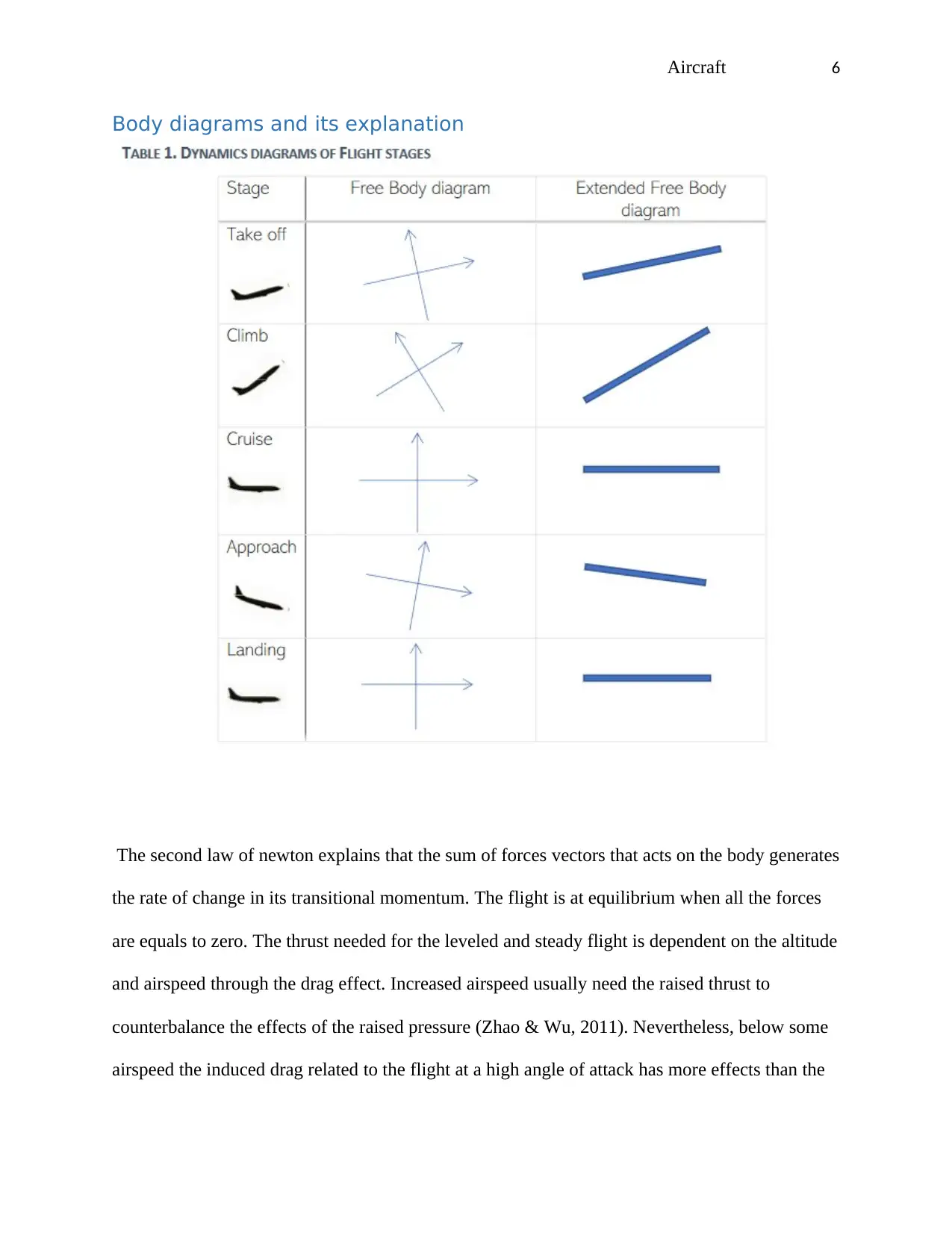
Aircraft 6
Body diagrams and its explanation
The second law of newton explains that the sum of forces vectors that acts on the body generates
the rate of change in its transitional momentum. The flight is at equilibrium when all the forces
are equals to zero. The thrust needed for the leveled and steady flight is dependent on the altitude
and airspeed through the drag effect. Increased airspeed usually need the raised thrust to
counterbalance the effects of the raised pressure (Zhao & Wu, 2011). Nevertheless, below some
airspeed the induced drag related to the flight at a high angle of attack has more effects than the
Body diagrams and its explanation
The second law of newton explains that the sum of forces vectors that acts on the body generates
the rate of change in its transitional momentum. The flight is at equilibrium when all the forces
are equals to zero. The thrust needed for the leveled and steady flight is dependent on the altitude
and airspeed through the drag effect. Increased airspeed usually need the raised thrust to
counterbalance the effects of the raised pressure (Zhao & Wu, 2011). Nevertheless, below some
airspeed the induced drag related to the flight at a high angle of attack has more effects than the
⊘ This is a preview!⊘
Do you want full access?
Subscribe today to unlock all pages.

Trusted by 1+ million students worldwide
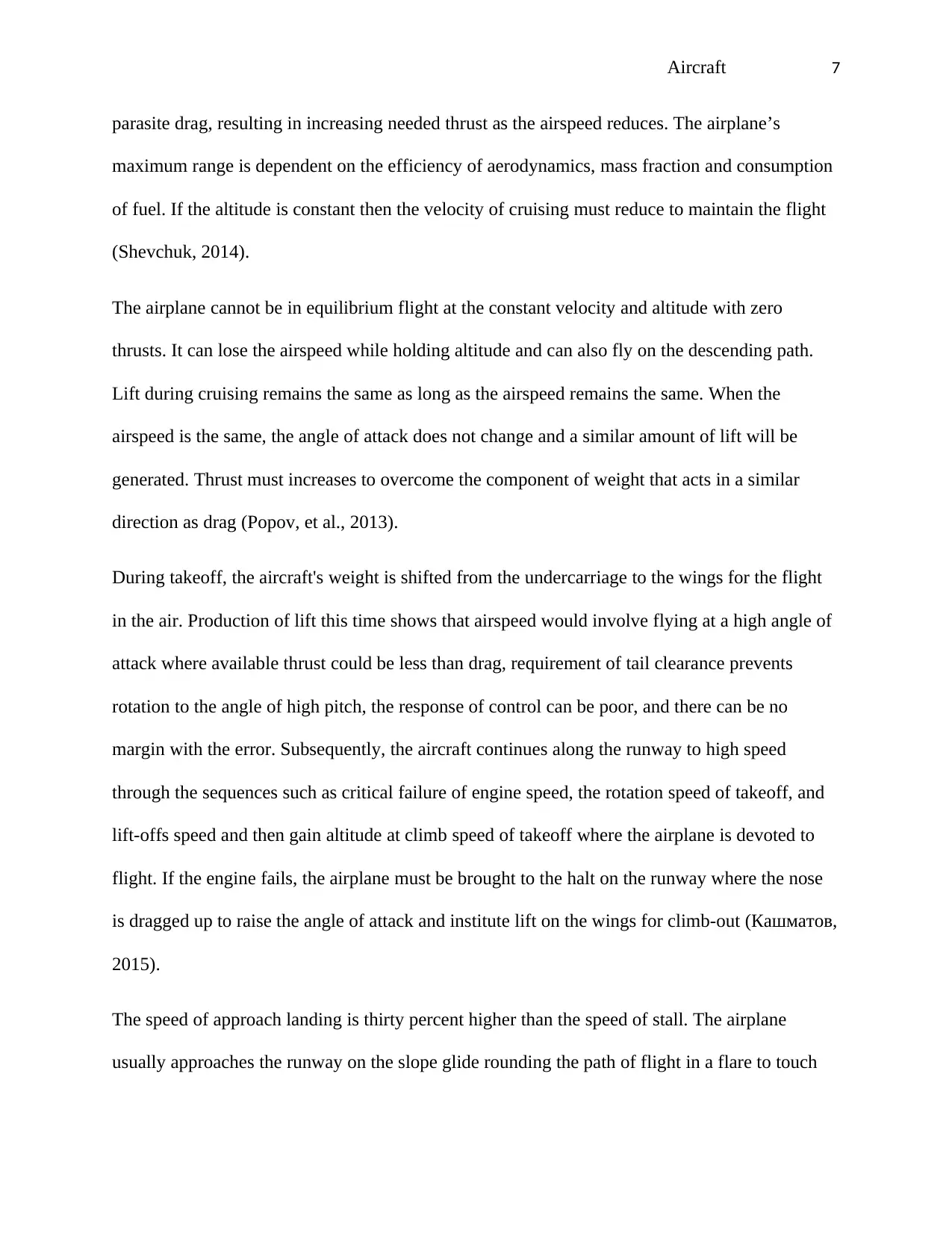
Aircraft 7
parasite drag, resulting in increasing needed thrust as the airspeed reduces. The airplane’s
maximum range is dependent on the efficiency of aerodynamics, mass fraction and consumption
of fuel. If the altitude is constant then the velocity of cruising must reduce to maintain the flight
(Shevchuk, 2014).
The airplane cannot be in equilibrium flight at the constant velocity and altitude with zero
thrusts. It can lose the airspeed while holding altitude and can also fly on the descending path.
Lift during cruising remains the same as long as the airspeed remains the same. When the
airspeed is the same, the angle of attack does not change and a similar amount of lift will be
generated. Thrust must increases to overcome the component of weight that acts in a similar
direction as drag (Popov, et al., 2013).
During takeoff, the aircraft's weight is shifted from the undercarriage to the wings for the flight
in the air. Production of lift this time shows that airspeed would involve flying at a high angle of
attack where available thrust could be less than drag, requirement of tail clearance prevents
rotation to the angle of high pitch, the response of control can be poor, and there can be no
margin with the error. Subsequently, the aircraft continues along the runway to high speed
through the sequences such as critical failure of engine speed, the rotation speed of takeoff, and
lift-offs speed and then gain altitude at climb speed of takeoff where the airplane is devoted to
flight. If the engine fails, the airplane must be brought to the halt on the runway where the nose
is dragged up to raise the angle of attack and institute lift on the wings for climb-out (Кашматов,
2015).
The speed of approach landing is thirty percent higher than the speed of stall. The airplane
usually approaches the runway on the slope glide rounding the path of flight in a flare to touch
parasite drag, resulting in increasing needed thrust as the airspeed reduces. The airplane’s
maximum range is dependent on the efficiency of aerodynamics, mass fraction and consumption
of fuel. If the altitude is constant then the velocity of cruising must reduce to maintain the flight
(Shevchuk, 2014).
The airplane cannot be in equilibrium flight at the constant velocity and altitude with zero
thrusts. It can lose the airspeed while holding altitude and can also fly on the descending path.
Lift during cruising remains the same as long as the airspeed remains the same. When the
airspeed is the same, the angle of attack does not change and a similar amount of lift will be
generated. Thrust must increases to overcome the component of weight that acts in a similar
direction as drag (Popov, et al., 2013).
During takeoff, the aircraft's weight is shifted from the undercarriage to the wings for the flight
in the air. Production of lift this time shows that airspeed would involve flying at a high angle of
attack where available thrust could be less than drag, requirement of tail clearance prevents
rotation to the angle of high pitch, the response of control can be poor, and there can be no
margin with the error. Subsequently, the aircraft continues along the runway to high speed
through the sequences such as critical failure of engine speed, the rotation speed of takeoff, and
lift-offs speed and then gain altitude at climb speed of takeoff where the airplane is devoted to
flight. If the engine fails, the airplane must be brought to the halt on the runway where the nose
is dragged up to raise the angle of attack and institute lift on the wings for climb-out (Кашматов,
2015).
The speed of approach landing is thirty percent higher than the speed of stall. The airplane
usually approaches the runway on the slope glide rounding the path of flight in a flare to touch
Paraphrase This Document
Need a fresh take? Get an instant paraphrase of this document with our AI Paraphraser
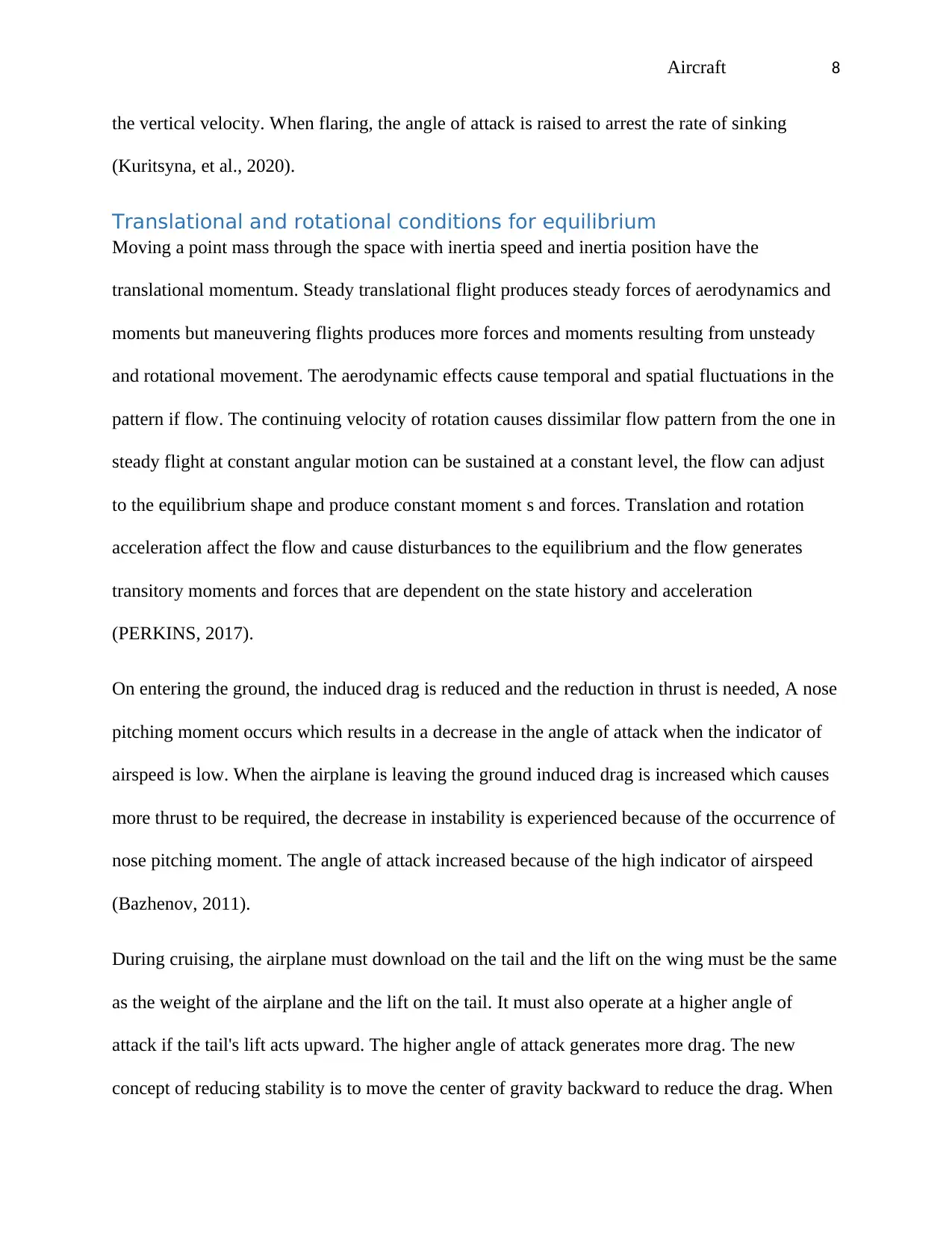
Aircraft 8
the vertical velocity. When flaring, the angle of attack is raised to arrest the rate of sinking
(Kuritsyna, et al., 2020).
Translational and rotational conditions for equilibrium
Moving a point mass through the space with inertia speed and inertia position have the
translational momentum. Steady translational flight produces steady forces of aerodynamics and
moments but maneuvering flights produces more forces and moments resulting from unsteady
and rotational movement. The aerodynamic effects cause temporal and spatial fluctuations in the
pattern if flow. The continuing velocity of rotation causes dissimilar flow pattern from the one in
steady flight at constant angular motion can be sustained at a constant level, the flow can adjust
to the equilibrium shape and produce constant moment s and forces. Translation and rotation
acceleration affect the flow and cause disturbances to the equilibrium and the flow generates
transitory moments and forces that are dependent on the state history and acceleration
(PERKINS, 2017).
On entering the ground, the induced drag is reduced and the reduction in thrust is needed, A nose
pitching moment occurs which results in a decrease in the angle of attack when the indicator of
airspeed is low. When the airplane is leaving the ground induced drag is increased which causes
more thrust to be required, the decrease in instability is experienced because of the occurrence of
nose pitching moment. The angle of attack increased because of the high indicator of airspeed
(Bazhenov, 2011).
During cruising, the airplane must download on the tail and the lift on the wing must be the same
as the weight of the airplane and the lift on the tail. It must also operate at a higher angle of
attack if the tail's lift acts upward. The higher angle of attack generates more drag. The new
concept of reducing stability is to move the center of gravity backward to reduce the drag. When
the vertical velocity. When flaring, the angle of attack is raised to arrest the rate of sinking
(Kuritsyna, et al., 2020).
Translational and rotational conditions for equilibrium
Moving a point mass through the space with inertia speed and inertia position have the
translational momentum. Steady translational flight produces steady forces of aerodynamics and
moments but maneuvering flights produces more forces and moments resulting from unsteady
and rotational movement. The aerodynamic effects cause temporal and spatial fluctuations in the
pattern if flow. The continuing velocity of rotation causes dissimilar flow pattern from the one in
steady flight at constant angular motion can be sustained at a constant level, the flow can adjust
to the equilibrium shape and produce constant moment s and forces. Translation and rotation
acceleration affect the flow and cause disturbances to the equilibrium and the flow generates
transitory moments and forces that are dependent on the state history and acceleration
(PERKINS, 2017).
On entering the ground, the induced drag is reduced and the reduction in thrust is needed, A nose
pitching moment occurs which results in a decrease in the angle of attack when the indicator of
airspeed is low. When the airplane is leaving the ground induced drag is increased which causes
more thrust to be required, the decrease in instability is experienced because of the occurrence of
nose pitching moment. The angle of attack increased because of the high indicator of airspeed
(Bazhenov, 2011).
During cruising, the airplane must download on the tail and the lift on the wing must be the same
as the weight of the airplane and the lift on the tail. It must also operate at a higher angle of
attack if the tail's lift acts upward. The higher angle of attack generates more drag. The new
concept of reducing stability is to move the center of gravity backward to reduce the drag. When
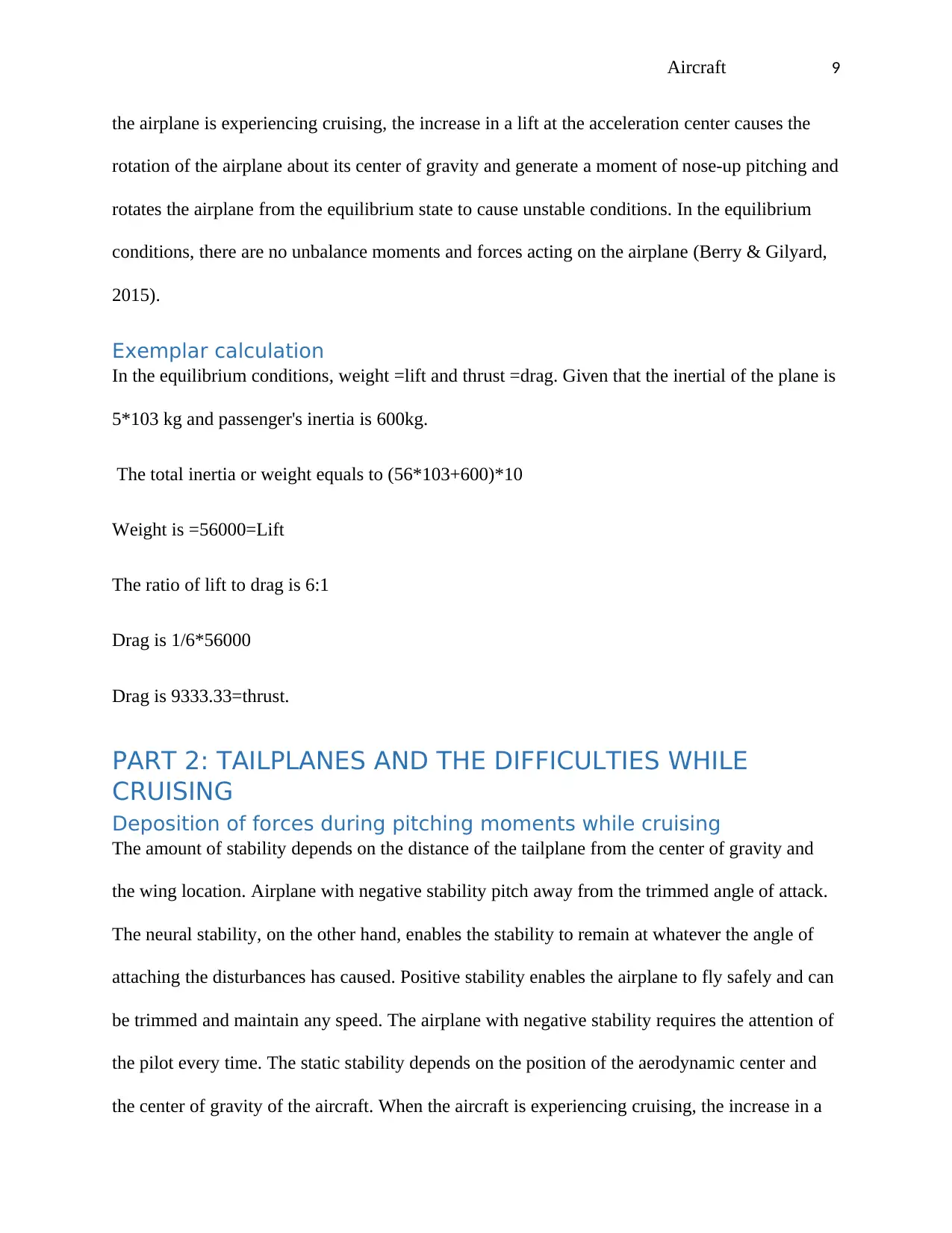
Aircraft 9
the airplane is experiencing cruising, the increase in a lift at the acceleration center causes the
rotation of the airplane about its center of gravity and generate a moment of nose-up pitching and
rotates the airplane from the equilibrium state to cause unstable conditions. In the equilibrium
conditions, there are no unbalance moments and forces acting on the airplane (Berry & Gilyard,
2015).
Exemplar calculation
In the equilibrium conditions, weight =lift and thrust =drag. Given that the inertial of the plane is
5*103 kg and passenger's inertia is 600kg.
The total inertia or weight equals to (56*103+600)*10
Weight is =56000=Lift
The ratio of lift to drag is 6:1
Drag is 1/6*56000
Drag is 9333.33=thrust.
PART 2: TAILPLANES AND THE DIFFICULTIES WHILE
CRUISING
Deposition of forces during pitching moments while cruising
The amount of stability depends on the distance of the tailplane from the center of gravity and
the wing location. Airplane with negative stability pitch away from the trimmed angle of attack.
The neural stability, on the other hand, enables the stability to remain at whatever the angle of
attaching the disturbances has caused. Positive stability enables the airplane to fly safely and can
be trimmed and maintain any speed. The airplane with negative stability requires the attention of
the pilot every time. The static stability depends on the position of the aerodynamic center and
the center of gravity of the aircraft. When the aircraft is experiencing cruising, the increase in a
the airplane is experiencing cruising, the increase in a lift at the acceleration center causes the
rotation of the airplane about its center of gravity and generate a moment of nose-up pitching and
rotates the airplane from the equilibrium state to cause unstable conditions. In the equilibrium
conditions, there are no unbalance moments and forces acting on the airplane (Berry & Gilyard,
2015).
Exemplar calculation
In the equilibrium conditions, weight =lift and thrust =drag. Given that the inertial of the plane is
5*103 kg and passenger's inertia is 600kg.
The total inertia or weight equals to (56*103+600)*10
Weight is =56000=Lift
The ratio of lift to drag is 6:1
Drag is 1/6*56000
Drag is 9333.33=thrust.
PART 2: TAILPLANES AND THE DIFFICULTIES WHILE
CRUISING
Deposition of forces during pitching moments while cruising
The amount of stability depends on the distance of the tailplane from the center of gravity and
the wing location. Airplane with negative stability pitch away from the trimmed angle of attack.
The neural stability, on the other hand, enables the stability to remain at whatever the angle of
attaching the disturbances has caused. Positive stability enables the airplane to fly safely and can
be trimmed and maintain any speed. The airplane with negative stability requires the attention of
the pilot every time. The static stability depends on the position of the aerodynamic center and
the center of gravity of the aircraft. When the aircraft is experiencing cruising, the increase in a
⊘ This is a preview!⊘
Do you want full access?
Subscribe today to unlock all pages.

Trusted by 1+ million students worldwide
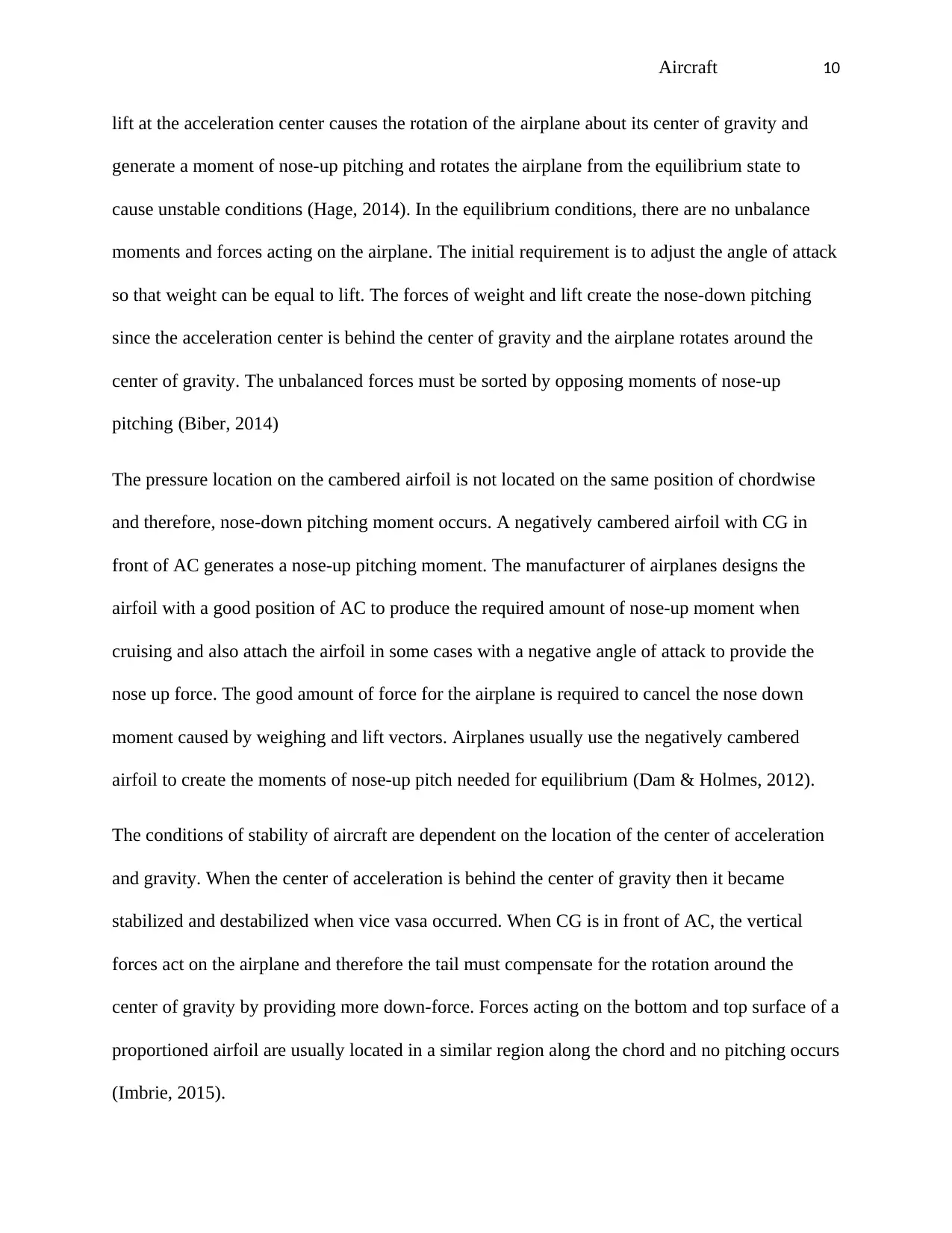
Aircraft 10
lift at the acceleration center causes the rotation of the airplane about its center of gravity and
generate a moment of nose-up pitching and rotates the airplane from the equilibrium state to
cause unstable conditions (Hage, 2014). In the equilibrium conditions, there are no unbalance
moments and forces acting on the airplane. The initial requirement is to adjust the angle of attack
so that weight can be equal to lift. The forces of weight and lift create the nose-down pitching
since the acceleration center is behind the center of gravity and the airplane rotates around the
center of gravity. The unbalanced forces must be sorted by opposing moments of nose-up
pitching (Biber, 2014)
The pressure location on the cambered airfoil is not located on the same position of chordwise
and therefore, nose-down pitching moment occurs. A negatively cambered airfoil with CG in
front of AC generates a nose-up pitching moment. The manufacturer of airplanes designs the
airfoil with a good position of AC to produce the required amount of nose-up moment when
cruising and also attach the airfoil in some cases with a negative angle of attack to provide the
nose up force. The good amount of force for the airplane is required to cancel the nose down
moment caused by weighing and lift vectors. Airplanes usually use the negatively cambered
airfoil to create the moments of nose-up pitch needed for equilibrium (Dam & Holmes, 2012).
The conditions of stability of aircraft are dependent on the location of the center of acceleration
and gravity. When the center of acceleration is behind the center of gravity then it became
stabilized and destabilized when vice vasa occurred. When CG is in front of AC, the vertical
forces act on the airplane and therefore the tail must compensate for the rotation around the
center of gravity by providing more down-force. Forces acting on the bottom and top surface of a
proportioned airfoil are usually located in a similar region along the chord and no pitching occurs
(Imbrie, 2015).
lift at the acceleration center causes the rotation of the airplane about its center of gravity and
generate a moment of nose-up pitching and rotates the airplane from the equilibrium state to
cause unstable conditions (Hage, 2014). In the equilibrium conditions, there are no unbalance
moments and forces acting on the airplane. The initial requirement is to adjust the angle of attack
so that weight can be equal to lift. The forces of weight and lift create the nose-down pitching
since the acceleration center is behind the center of gravity and the airplane rotates around the
center of gravity. The unbalanced forces must be sorted by opposing moments of nose-up
pitching (Biber, 2014)
The pressure location on the cambered airfoil is not located on the same position of chordwise
and therefore, nose-down pitching moment occurs. A negatively cambered airfoil with CG in
front of AC generates a nose-up pitching moment. The manufacturer of airplanes designs the
airfoil with a good position of AC to produce the required amount of nose-up moment when
cruising and also attach the airfoil in some cases with a negative angle of attack to provide the
nose up force. The good amount of force for the airplane is required to cancel the nose down
moment caused by weighing and lift vectors. Airplanes usually use the negatively cambered
airfoil to create the moments of nose-up pitch needed for equilibrium (Dam & Holmes, 2012).
The conditions of stability of aircraft are dependent on the location of the center of acceleration
and gravity. When the center of acceleration is behind the center of gravity then it became
stabilized and destabilized when vice vasa occurred. When CG is in front of AC, the vertical
forces act on the airplane and therefore the tail must compensate for the rotation around the
center of gravity by providing more down-force. Forces acting on the bottom and top surface of a
proportioned airfoil are usually located in a similar region along the chord and no pitching occurs
(Imbrie, 2015).
Paraphrase This Document
Need a fresh take? Get an instant paraphrase of this document with our AI Paraphraser
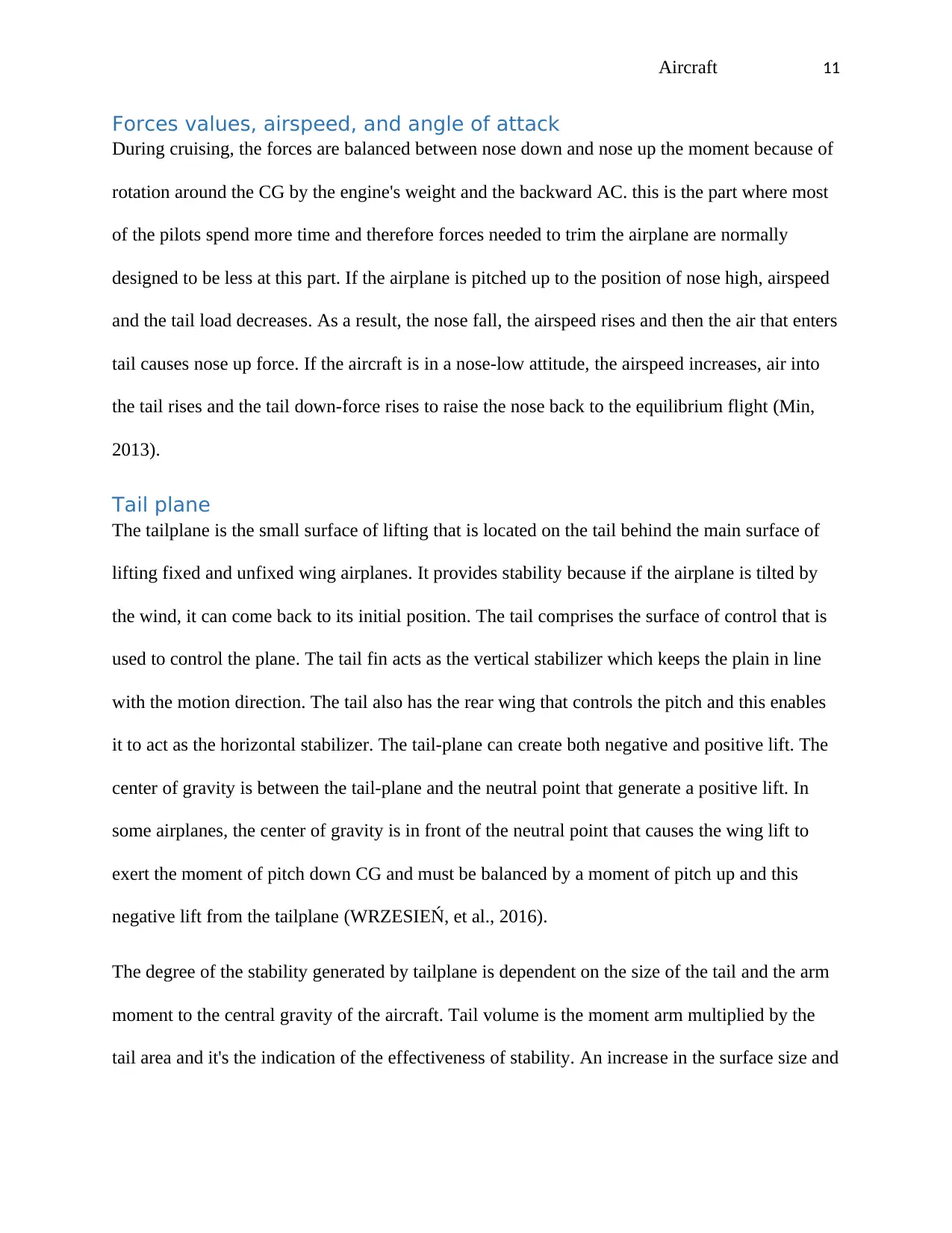
Aircraft 11
Forces values, airspeed, and angle of attack
During cruising, the forces are balanced between nose down and nose up the moment because of
rotation around the CG by the engine's weight and the backward AC. this is the part where most
of the pilots spend more time and therefore forces needed to trim the airplane are normally
designed to be less at this part. If the airplane is pitched up to the position of nose high, airspeed
and the tail load decreases. As a result, the nose fall, the airspeed rises and then the air that enters
tail causes nose up force. If the aircraft is in a nose-low attitude, the airspeed increases, air into
the tail rises and the tail down-force rises to raise the nose back to the equilibrium flight (Min,
2013).
Tail plane
The tailplane is the small surface of lifting that is located on the tail behind the main surface of
lifting fixed and unfixed wing airplanes. It provides stability because if the airplane is tilted by
the wind, it can come back to its initial position. The tail comprises the surface of control that is
used to control the plane. The tail fin acts as the vertical stabilizer which keeps the plain in line
with the motion direction. The tail also has the rear wing that controls the pitch and this enables
it to act as the horizontal stabilizer. The tail-plane can create both negative and positive lift. The
center of gravity is between the tail-plane and the neutral point that generate a positive lift. In
some airplanes, the center of gravity is in front of the neutral point that causes the wing lift to
exert the moment of pitch down CG and must be balanced by a moment of pitch up and this
negative lift from the tailplane (WRZESIEŃ, et al., 2016).
The degree of the stability generated by tailplane is dependent on the size of the tail and the arm
moment to the central gravity of the aircraft. Tail volume is the moment arm multiplied by the
tail area and it's the indication of the effectiveness of stability. An increase in the surface size and
Forces values, airspeed, and angle of attack
During cruising, the forces are balanced between nose down and nose up the moment because of
rotation around the CG by the engine's weight and the backward AC. this is the part where most
of the pilots spend more time and therefore forces needed to trim the airplane are normally
designed to be less at this part. If the airplane is pitched up to the position of nose high, airspeed
and the tail load decreases. As a result, the nose fall, the airspeed rises and then the air that enters
tail causes nose up force. If the aircraft is in a nose-low attitude, the airspeed increases, air into
the tail rises and the tail down-force rises to raise the nose back to the equilibrium flight (Min,
2013).
Tail plane
The tailplane is the small surface of lifting that is located on the tail behind the main surface of
lifting fixed and unfixed wing airplanes. It provides stability because if the airplane is tilted by
the wind, it can come back to its initial position. The tail comprises the surface of control that is
used to control the plane. The tail fin acts as the vertical stabilizer which keeps the plain in line
with the motion direction. The tail also has the rear wing that controls the pitch and this enables
it to act as the horizontal stabilizer. The tail-plane can create both negative and positive lift. The
center of gravity is between the tail-plane and the neutral point that generate a positive lift. In
some airplanes, the center of gravity is in front of the neutral point that causes the wing lift to
exert the moment of pitch down CG and must be balanced by a moment of pitch up and this
negative lift from the tailplane (WRZESIEŃ, et al., 2016).
The degree of the stability generated by tailplane is dependent on the size of the tail and the arm
moment to the central gravity of the aircraft. Tail volume is the moment arm multiplied by the
tail area and it's the indication of the effectiveness of stability. An increase in the surface size and
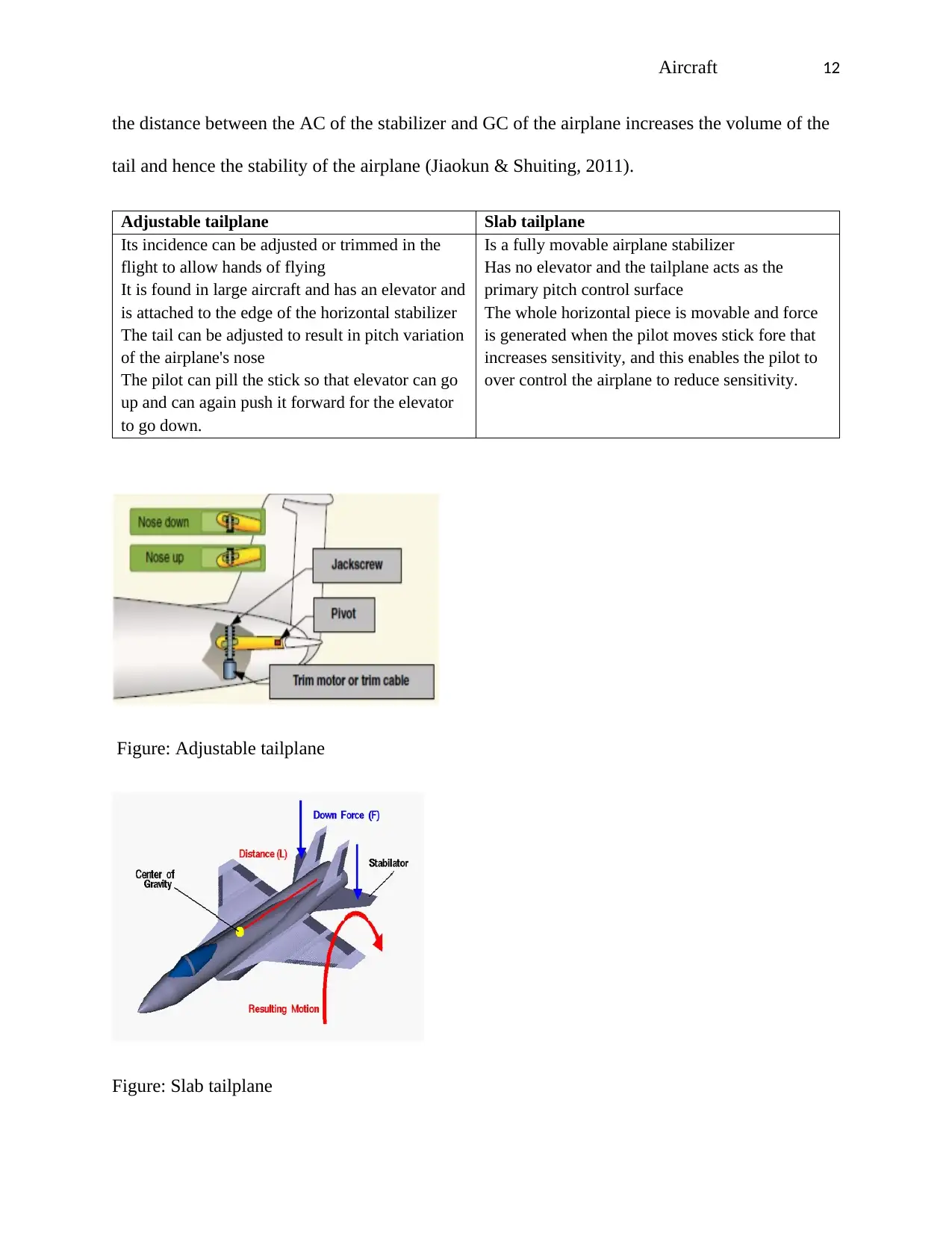
Aircraft 12
the distance between the AC of the stabilizer and GC of the airplane increases the volume of the
tail and hence the stability of the airplane (Jiaokun & Shuiting, 2011).
Adjustable tailplane Slab tailplane
Its incidence can be adjusted or trimmed in the
flight to allow hands of flying
It is found in large aircraft and has an elevator and
is attached to the edge of the horizontal stabilizer
The tail can be adjusted to result in pitch variation
of the airplane's nose
The pilot can pill the stick so that elevator can go
up and can again push it forward for the elevator
to go down.
Is a fully movable airplane stabilizer
Has no elevator and the tailplane acts as the
primary pitch control surface
The whole horizontal piece is movable and force
is generated when the pilot moves stick fore that
increases sensitivity, and this enables the pilot to
over control the airplane to reduce sensitivity.
Figure: Adjustable tailplane
Figure: Slab tailplane
the distance between the AC of the stabilizer and GC of the airplane increases the volume of the
tail and hence the stability of the airplane (Jiaokun & Shuiting, 2011).
Adjustable tailplane Slab tailplane
Its incidence can be adjusted or trimmed in the
flight to allow hands of flying
It is found in large aircraft and has an elevator and
is attached to the edge of the horizontal stabilizer
The tail can be adjusted to result in pitch variation
of the airplane's nose
The pilot can pill the stick so that elevator can go
up and can again push it forward for the elevator
to go down.
Is a fully movable airplane stabilizer
Has no elevator and the tailplane acts as the
primary pitch control surface
The whole horizontal piece is movable and force
is generated when the pilot moves stick fore that
increases sensitivity, and this enables the pilot to
over control the airplane to reduce sensitivity.
Figure: Adjustable tailplane
Figure: Slab tailplane
⊘ This is a preview!⊘
Do you want full access?
Subscribe today to unlock all pages.

Trusted by 1+ million students worldwide
1 out of 16
Related Documents
Your All-in-One AI-Powered Toolkit for Academic Success.
+13062052269
info@desklib.com
Available 24*7 on WhatsApp / Email
![[object Object]](/_next/static/media/star-bottom.7253800d.svg)
Unlock your academic potential
Copyright © 2020–2025 A2Z Services. All Rights Reserved. Developed and managed by ZUCOL.



